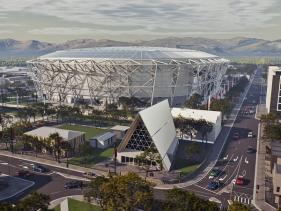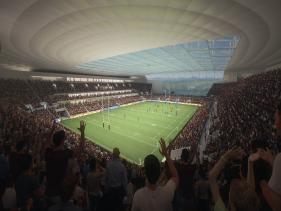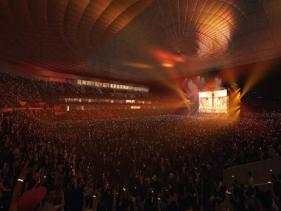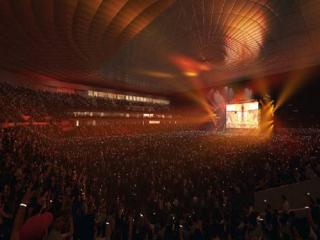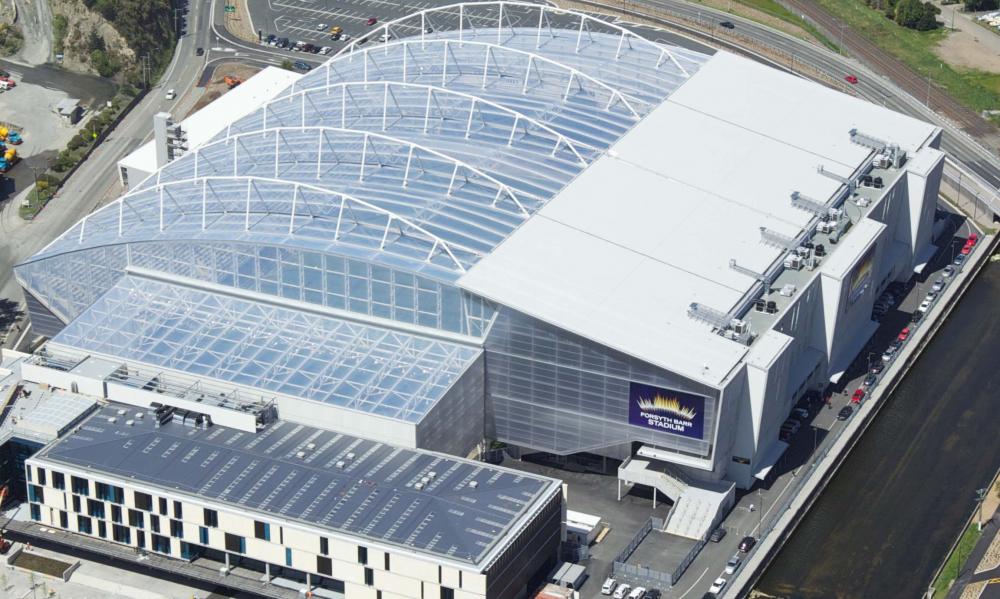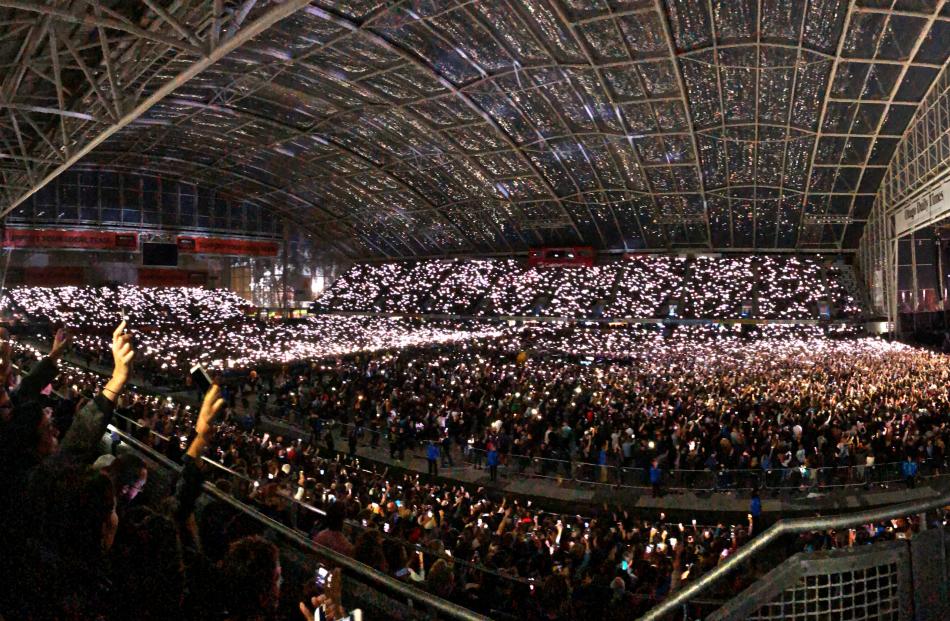Christchurch

Construction to start in 2022 with a 2026 target to open
The Investment Case said that in order for the Canterbury Multi-Use Arena to be competitive and attract international and national events, it needs to have:
- A roof so it can host events year-round.
- Minimum seating capacity of 30,000 (with the potential to add temporary seating for a further 5000 in the future).
- A fixed rectangular turf.
- High quality acoustics.
Based on those specifications, it is projected the arena will cost $683 million to build.
We get a Roof and permanent seating for about 30,000, with capacity to add extra seating. " Dunedin has shown that a roof is a no brainer". It will be nice to knowing having spent your hard earned money on an expensive event that you are not going to need a poncho or 3 layers of clothes "some also may remember the Final of the 2006 Super 14 season where fog prevented viewers from seeing the game".
If designed correctly, the arena could be a leading venue in New Zealand and we may see some great events, adding a much needed boost to the local economy and increasing tourism in the region.
Hopefully in the design they will finally eliminate the long lines at the women’s toilets and work out a way in which the food is still hot when you buy it at a big game or event "or will this just be too much to expect?".
Christchurch Stadium, Canterbury Arena Christchurch
Work on Te Kaha, Canterbury’s Multi-Use Arena, will hit a new milestone later this month when the first of the foundations’ major concrete pours is completed.
Te Kaha Project Delivery Chief Executive David Kennedy says the lead contractor, BESIX Watpac, will oversee about 40 large concrete pours between 27 January and mid-August, as work begins on the arena’s substructure.
“These concrete pours are significant as they signal the start of the main construction of Te Kaha,” says Mr Kennedy.
“The substructure is a crucial element as it will enable the land to support the huge 30,000-seat arena, and ensure it can withstand any seismic activity in the future.
“Most of the concrete pours are likely to begin at about 2am. This will help minimise heat stress on staff and minimise the risk of traffic congestion during peak morning periods, ensure consistent concrete supply and keep the concrete cooler.”
“To help minimise the noise for nearby residents and businesses, contractors will set up during daylight hours, locate the equipment and machinery in the middle of the site so they are as far from neighbours as possible, use quieter equipment and minimise activities that create noise.
Nosie barriers will also be used where practical, and subcontractors will undertake additional training.
The concrete pours will begin on the Madras Street side of the site, establishing the foundations for the western stand.
The pours will then follow the ground improvement early work that is continuing across the site, finishing with the northern and eastern stands later this year.
BESIX Watpac’s design and construction programme for the $683-million Te Kaha project remains on-budget and on-schedule,
Once completed in April 2026, the state-of-the-art multi-use arena will have a seating capacity of 30,000 for sports events and will hold a minimum 36,000 spectators for large music events.
For more information on the project, visit canterburyarena.co.nz
You can read the Start Works Notice for the concrete pours here.
The Saga of Our Stadium Well some of it at least as it could fill a book to try and explain the years of snail's pace decision making
In 2021 we asked would $473 million be enough to build the stadium the people want?
Answer to that was a resounding No! With a new cost of $683 million Te Kaha is the largest project ever undertaken by the Council.
Back in 2021 Christchurch City Council allocated $253 million to the Christchurch Rugby Stadium, with Central Government confirming it had earmarked $220 million for the project.
To some the council was dragging its heels over this much wanted asset; others may have felt it should be used elsewhere.
Finally the funding was brought forward following strong support from the community and most likely the 2019 elections helped or so we thought.
Dragging into 2022 the council managed to delay the project yet again, and then propose more downsizing as surprise the costs had gone up, who would have guessed that.
ChristchurchNZ chief executive was reported to have said as being "really comfortable” with the stadium’s capacity of 25,000 permanent seats. This may be seen by some as being slightly in inconsistent to a Verbal Submission she made on the 09.05.18 to the CCC.
When requesting for increased funding for Christchurchnz a great deal of emphasis was placed on the Forsyth Barr Stadium in Dunedin and events arising from having a stadium with a larger capacity.
Such as the pop singer Ed Sheeran who performed to more than 108,000 fans during three shows, as well as referring to All Blacks games as being essential to Christchurch city.
Former Christchurch Regeneration Minister and National MP Gerry Brownlee is on record as saying 30,000 should be the minimum number of seats the Christchurch stadium should have.
Back in 2021 we asked will the original budget be enough, unlikely as Initial cost estimates reported by council for the options range from $460 million to $520 million at the time.
As this didn't take into account budget over-runs which given past performance on public projects we can be forgiven when we expect it to cost more than any estimate provided which no surprise it did by over $200 million.
As a multi-functional arena the plan is for it to cater for a range of activities, particularly large-scale local, national and international events. The multi-use arena will host a range of activities, including various sporting events, entertainment, concerts, trade shows, conferences, exhibitions, festivals, and community activities.
Back in 2021 the goal was to get construction under way so the arena can open in 2024, allowing Christchurch to reclaim its position as New Zealand’s sporting and cultural capital.
Given how much Christchurch has missed out on by not having a stadium it couldn’t happen fast enough.
Well unfortunately it’s going to be at least April 2026 before the gates will be opened and lets not hold our breath as your likely to run out of air given the performance to date.
In 2021 the council stated that the company’s board will be tasked with ensuring that this important project the last of the anchor projects in the Christchurch Central Recovery Plan is completed within project timelines and budget "well what happened to that $200 million over budget and two years delayed”?
The arena was to be one of the anchor projects included in the Christchurch Central Recovery Plan and is going to be built in the city centre on Crown-owned land bordered by Madras, Barbadoes, Hereford and Tuam streets.
The Investment Case says that in order for the Canterbury Multi-Use Arena to be competitive and attract international and national events, it needs to have:
- A roof so it can host events year-round.
- Minimum seating capacity of 25,000 (with the potential to add temporary seating for a further 5000 in the future).
- A fixed rectangular turf.
- High quality acoustics.
Based on those specifications, it was projected the arena would cost $472.7 million to build.
The net operating costs for the arena, including lifecycle costs, are anticipated in the Investment Case to be $4.2 million per annum.
The Investment Case recommends the Council take the lead in delivering the project once a funding agreement between the Crown and Council is in place “that decision may not have been the best ever”.
Under the suggested delivery model, the Council would appoint a Project Board who would then independently appoint a delivery team who would pull together consortia of contractors to build the arena.
The Project Board would oversee delivery of the project and would be responsible for ensuring it is delivered on schedule and in budget.
“Modelling undertaken for the investment case conservatively estimates that stays in Christchurch will increase by nearly 100,000 bed-nights per annum because of the domestic and international tourism driven by the new arena,’’ Mr Pearson says.
When is construction likely to start?
Enabling works were expected to commence on-site in quarter two of 2020.
Actual work appears to have started in 2022
How long will construction take?
The arena is expected to open in 2026.
Has any work begun on site?
Geotechnical investigations have been under way on the site since late 2018. We needed to determine the condition of the land so that could be factored into the planning for the arena. Some site remediation work has also been done.
Why can’t we continue using Christchurch Stadium?
Christchurch Stadium was designed only as a temporary facility and is small – it has a seating capacity of only 18,000 – when compared with other venues around New Zealand. The facility is ageing and the stadium is uncovered, resulting in poor patronage and performer experience.
Who will operate the arena?
Council-owned entity Vbase is the proposed operator of the arena.
Who put the Investment Case together?
Council engaged professional services firm EY to work collaboratively with staff to develop the Investment Case. Additional input has come from industry experts, specialist consultants and various stakeholders. Crown agencies have also helped by providing advice on the Government funding approval processes.
How much did the Investment Case cost to prepare?
About $3 million.



